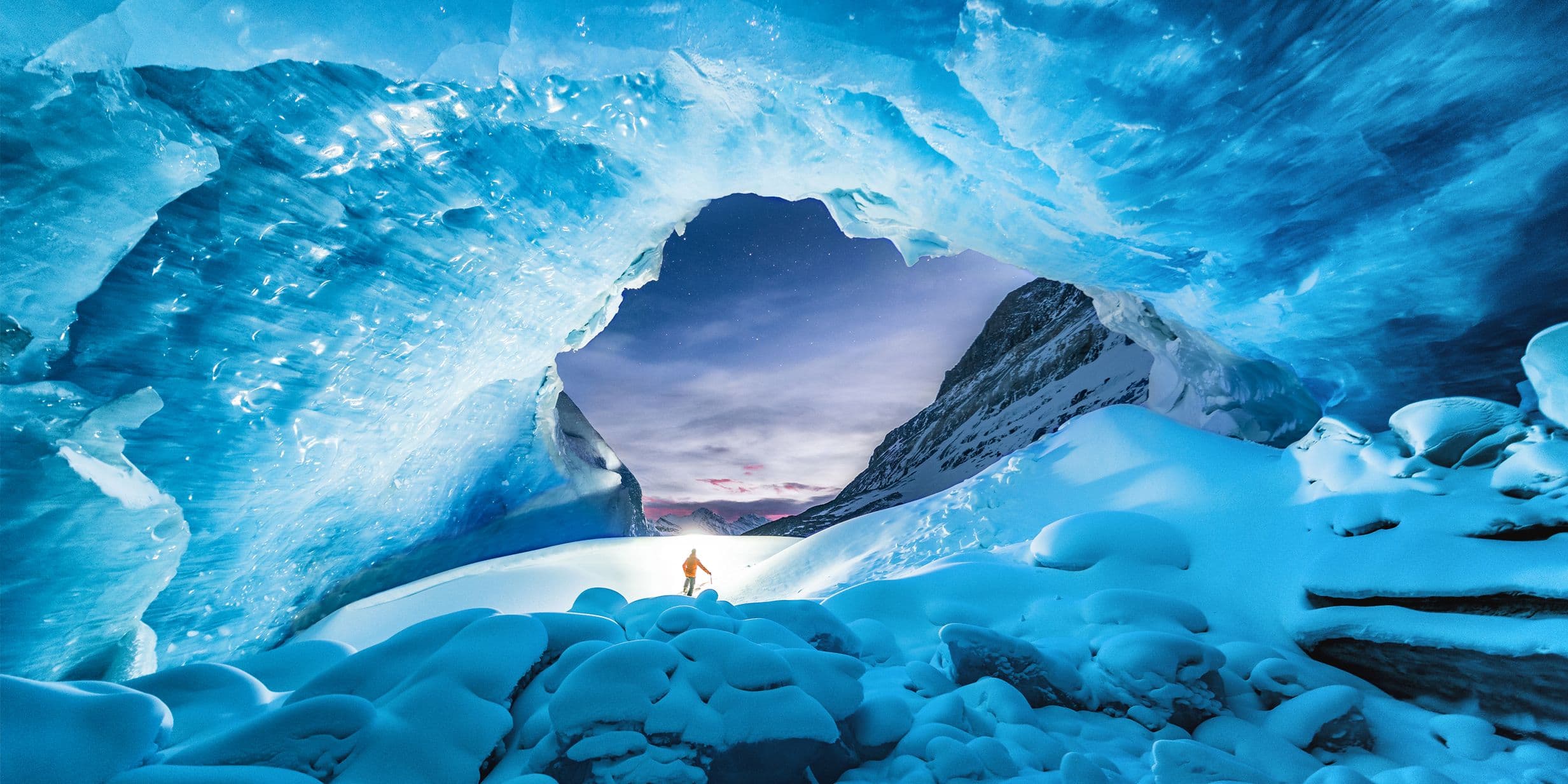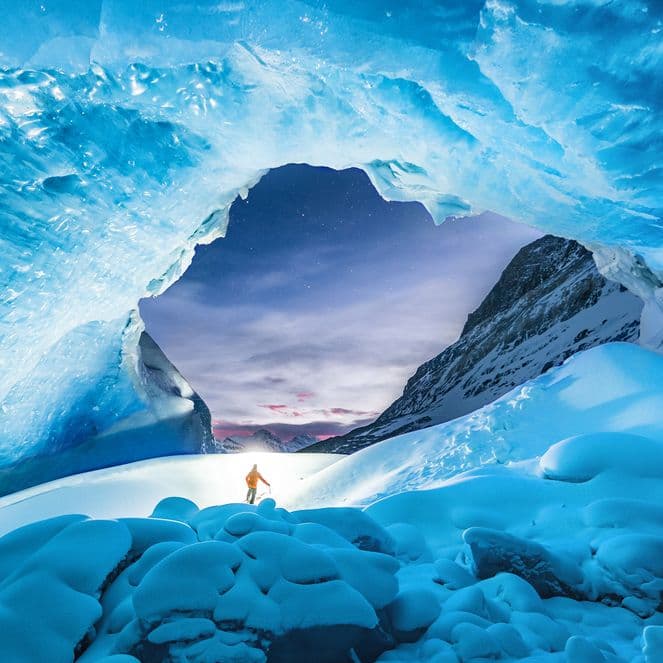Fotografie
Auf der Suche nach dem Winterlicht: Ein Leitfaden für Fotos im Schnee
Von Banff in Kanada bis zu den Gipfeln der Alpen: Der Fotograf Will Lambert verrät uns seine Geheimnisse für atemberaubende Schneefotos.


Fotografie
Von Banff in Kanada bis zu den Gipfeln der Alpen: Der Fotograf Will Lambert verrät uns seine Geheimnisse für atemberaubende Schneefotos.


Der in Banff lebende Fotograf Will Lambert verbringt seine Tage damit, das Licht über den Berggipfeln Kanadas zu jagen. Als preisgekrönter Action- und Abenteuerspezialist fängt er mit seiner Kamera alles ein – von rasanten Skiabfahrten bis zu ruhigen Momenten im Schnee.
Ich erinnere mich noch gut daran, als ich zum ersten Mal versuchte, im Banff-Nationalpark bei einem Schneesturm Fotos zu machen: Mein Objektiv vereiste, meine Finger waren steif vor Kälte und ich dachte: „Ist das überhaupt möglich?“ Ich bin in Sheffield aufgewachsen, wo Schnee für mich immer etwas aus Weihnachtsfilmen statt aus dem wirklichen Leben war. Meine Familie verbrachte die Wochenenden mit Wanderungen in den Hügeln von Yorkshire oder mit Erkundungstouren im Lake District und in Schottland – mit Regen, schlammigen Stiefeln und in Alufolie eingewickeltem Kuchen. Sowohl mein Großvater als auch mein Vater waren begeisterte Fotografen, und die Abende verbrachten wir gemeinsam um einen Projektor herum, um uns ihre Bilder anzuschauen. Diese Leidenschaft hat auch mich zur Fotografie gebracht – die Idee, das Gefühl eines Orten einzufangen, nicht nur sein Aussehen.
Foto: Will Lambert
Will und seine Familie im Jahr 1993
Will auf der Piste
Mein erstes ernsthaftes Fotoabenteuer begann in den österreichischen Alpen, wo ich meine Liebe zu den Bergen, zum Skifahren und zum Geschichtenerzählen verbinden konnte. 2016 bin ich nach Kanada gezogen, wo der Winter in den Rocky Mountains über 200 Tage lang ist. Ich musste lernen, die Kälte und die Unvorhersehbarkeit des Winters zu akzeptieren und die Einfachheit des Schnees zu entdecken. Im Laufe der Jahre habe ich ein paar wichtige Lektionen gelernt, die die Schneefotografie sowohl herausfordernd als auch lohnenswert machen.
Foto: Will Lambert
Eine verschneite Welt fühlt sich wie ein unbeschriebenes Blatt an. Landschaften, die ich schon unzählige Male fotografiert habe, verändern sich im Schnee stetig und werden von Licht und Schatten geformt. Der Winter hat eine Stille, die es einem ermöglicht, langsamer zu werden und wirklich zu sehen, was vor einem liegt. Meine Leidenschaft fürs Skifahren und für die Fotografie lässt sich hier perfekt verbinden: Es fühlt sich lebendig und kreativ an, das Licht durch den frischen Pulverschnee zu jagen oder eine Kurve im unberührten Schnee einzufangen. Gefrorene Finger, beschlagene Objektive und die grelle Mittagssonne gehören dazu – aber es ist genau diese Balance zwischen Unbehagen und Schönheit, die die Schneefotografie so erfüllend macht.
Foto: Will Lambert
Das Fotografieren von Schnee während der blauen und goldenen Stunden – kurz vor Sonnenaufgang oder nach Sonnenuntergang – hat etwas Magisches. Sanfte Pastelltöne tauchen die Landschaft in Rosa, Violett und Gold, wobei der Schnee wie ein riesiger Reflektor wirkt. Einige meiner liebsten Morgenstunden habe ich in der Stille von Banff verbracht, als das erste Licht die Gipfel streifte. Mit Versuchen, den Weißabgleich auf „Schatten” einzustellen oder die Kelvin-Temperatur anzupassen, um die Wärme in kühlen Tönen hervorzuheben. Das frühe Aufstehen lohnt sich – diese flüchtigen Minuten ermöglichen traumhafte Bilder.
Foto: Will Lambert
Schnee kann den Belichtungsmesser deiner Kamera täuschen, was zu stumpfen, grauen Bildern führt. Ich belichte fast immer mit +1 EV, manchmal sogar mit +2 bei starkem Schneefall oder bewölktem Himmel, damit die Weißtöne klar und naturgetreu bleiben. Überprüfe dein Histogramm, um überbelichtete Bereiche zu vermeiden, und fotografiere immer im RAW-Format – das gibt dir die Flexibilität, die Farbtöne anzupassen, ohne die natürliche Brillanz des Schnees zu verlieren.
Foto: Will Lambert
Kaltes Wetter wirkt sich sowohl auf dich als auch auf deine Ausrüstung aus. Die Akkus entladen sich schnell, deshalb habe ich immer Ersatzakkus in meiner Tasche dabei. Objektive beschlagen, wenn sie aus der Kälte ins Warme kommen, deshalb lasse ich meine Kameras langsam in meiner Tasche akklimatisieren. Einfache Abdeckungen – sogar eine Plastiktüte – können deine Ausrüstung bei starkem Schneefall schützen. Das habe ich auf die harte Tour im Sunshine Village in Banff gelernt: Kondenswasser hätte fast einen Nachmittag voller Aufnahmen ruiniert. Seitdem hat mir sorgfältige Vorbereitung unzählige Aufnahmen gerettet. Halte ein Mikrofasertuch griffbereit und bewahre Objektive immer in verschlossenen Beuteln auf, wenn du zwischen verschiedenen Temperaturen wechselst.
Foto: Will Lambert
Foto: Will Lambert
Schnee kann Szenen flach wirken lassen. Ich verlasse mich auf Bäume, Felsen, Schatten oder Menschen, um den Bildausschnitt besser zu verankern und Tiefe zu schaffen. Suche nach einem dunklen Element, um weiße Flächen aufzubrechen. Ein einzelner Baum, ein Wanderer oder ein Schatten, der sich über den frischen Schnee erstreckt, kann eine einfache Komposition in eine fesselnde Aufnahme verwandeln. Hier ist eines meiner Lieblingsbeispiele: ein Baum als Silhouette vor sanften Schneedünen – minimalistisch und doch beeindruckend.
Foto: Will Lambert
Bewölkte Tage eignen sich perfekt für Tier- und Landschaftsfotos. Weiches, gleichmäßiges Licht reduziert harte Schatten und hebt subtile Strukturen in Schnee, Fell oder Federn hervor. Ich nutze den Schnee als natürlichen Reflektor oder suche schattige Bereiche, um grelles Sonnenlicht zu streuen. Bewölkte Bedingungen sind ideal, um Details und subtile Strukturen ohne harte Kontraste einzufangen. Dieses sanfte Licht hält jedes Detail sichtbar und erzeugt intime, lebensechte Bilder, während die ruhige Winterstimmung erhalten bleibt.
Foto: Will Lambert
Das Fotografieren von Skifahren oder Snowboarden verleiht einer Aufnahme Energie und erzählt eine Geschichte. Während ich einem Skifahrer im Pulverschnee oder einem Snowboarder beim Springen zusehe, fotografiere ich mit sehr kurzen Verschlusszeiten (1/2000 s+) und verwende den Burst-Modus, um auch jede Schneeflocke und jede Kurve einzufangen. Verwende kurze Verschlusszeiten, um Bewegungen scharf einzufangen, und den Serienbildmodus, um den perfekten Moment festzuhalten. Das Ergebnis verwandelt eine einfache Abfahrt in eine lebendige Geschichte voller Geschwindigkeit, Können und Begeisterung, die den Betrachter die Faszination der Berge hautnah spüren lässt.
Foto: Will Lambert
Mit längeren Brennweiten (100 mm+) kann ich Motive, Texturen und Licht isolieren. Durch die Komprimierung der Komposition werden Kontraste, Muster und subtile Texturen hervorgehoben, die bei Weitwinkelaufnahmen verloren gehen würden. Schatten werden schärfer, Linien klarer und Formen grafischer. Konzentriere dich auf ein Element pro Bild, um starke minimalistische Kompositionen zu schaffen. Ein einsamer, in Wolken gehüllter Gipfel, eine Spur im Pulverschnee oder ein Skifahrer auf einer Piste rücken in den Fokus und sorgen so für eine visuell beeindruckende Aufnahme.
Ich denke oft in Sequenzen: Ausrüstung zusammenpacken, loswandern, den Gipfel erreichen und wieder zurück. Serien wie diese lassen die Betrachter die Reise miterleben – die Anstrengungen, die Herausforderungen, die Ehrfurcht vor der Natur. Die Anordnung von Bildern funktioniert hervorragend in Popsa-Fotobüchern, in denen zusammenhängende visuelle Erzählungen zur Geltung kommen. Kleine Details – Fußspuren im frischen Schnee, eine dampfende Tasse Kaffee – tragen dazu bei, eine vollständige Geschichte zu vermitteln. Betrachte Aufnahmen als miteinander verbundene Momente und nicht als isolierte Bilder.
Fotografieren im Schnee ist eine Herausforderung, aber sie kann sich auch sehr lohnen. Jede Flocke, jeder Schatten und jede Textur bieten eine neue Perspektive. Geh raus, experimentiere und hab keine Angst, die Regeln zu brechen. Erkunde deine Umgebung, spiel mit dem Licht und halte sowohl Details als auch Landschaften fest. Mehr von meinen Winterarbeiten kannst du in meinen Galerien sehen. Folge mir auf Instagram unter @WJLPhoto, wenn dich Einblicke hinter die Kulissen, saisonale Aufnahmen und Abenteuer in Echtzeit interessieren. Ich kann es kaum erwarten, deine Schneegeschichten zu sehen!